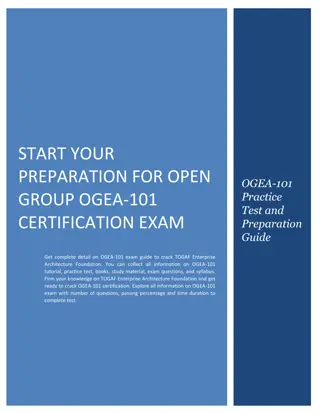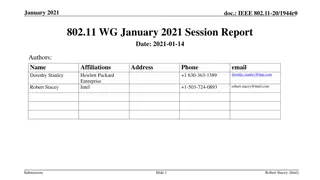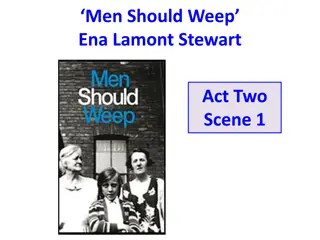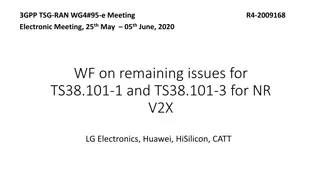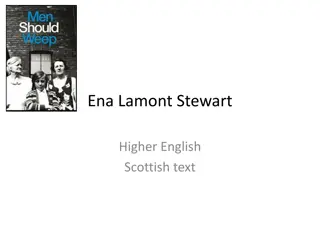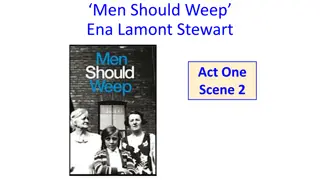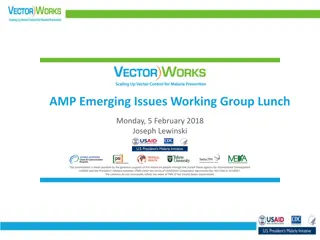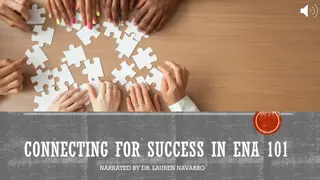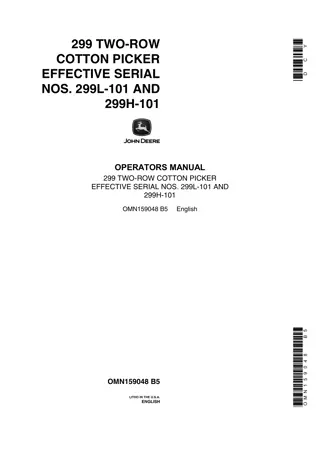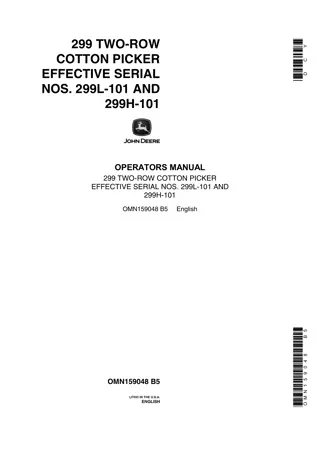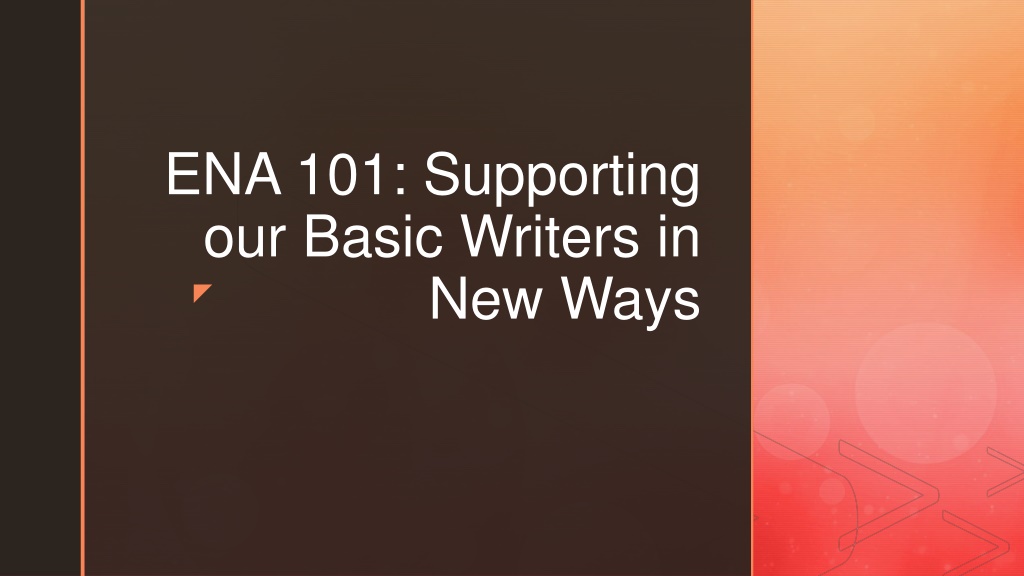
Supporting Basic Writers: ENA 101 New Approaches
Explore how the ENA 101 program is evolving to better support basic writers post-CATW era. Learn about the working group members, objectives, methodology, and structural changes being proposed. Get insights on best practices and campus resources for developing writers.
Download Presentation

Please find below an Image/Link to download the presentation.
The content on the website is provided AS IS for your information and personal use only. It may not be sold, licensed, or shared on other websites without obtaining consent from the author. If you encounter any issues during the download, it is possible that the publisher has removed the file from their server.
You are allowed to download the files provided on this website for personal or commercial use, subject to the condition that they are used lawfully. All files are the property of their respective owners.
The content on the website is provided AS IS for your information and personal use only. It may not be sold, licensed, or shared on other websites without obtaining consent from the author.
E N D
Presentation Transcript
ENA 101: Supporting our Basic Writers in New Ways
Working Group Members (Liz) Allia Abdullah-Matta, Olga Aksakalova, Ece Aykol, Evelyn Burg, J. Elizabeth Clark, Rochell Isaac, Jason Hendrickson, Jacqueline Jones, Jayashree Kamble, Marisa Klages-Bombich, Irwin Leopando, Lucy McNair, Neil Meyer, Joy Sanchez-Taylor, Lilla Toke, Dominique Zino
Objectives (Liz) Determine how ENA should be revised in a post-CATW era. Develop materials. Share curriculum revisions and materials with the department. Considering presentations at the national ALP conference, CCCC 2019, and potential publications in the Journal of Basic Writing, TETYC, or other forums.
Methodology (Liz) Research literature: Review best practices in ALP Pedagogy; Review best practices in Basic Writing Pedagogy; Review best practices in Writing Centers Research practices from other campuses: ALP syllabi, Comp I syllabi; Writing Center offerings & practices Situate our ALP Course at LaGuardia: Review LaGuardia s ENG 101 Course Goals; Review LaGuardia s ENG 102 Course Goals Recommend structured curriculum changes: Align ENA 101 to support course goals Develop & Document: new and existing practices in our own courses Work digitally, in classes, and in person to share findings. Met monthly from September January.
Whats the same? Whats different? (Liz) The CATW has been removed from all accelerated courses throughout CUNY. This allows for greater focus and emphasis on supporting developing writers using a purer version of the Baltimore ALP approach. The course structure remains the same: a section of ENG 101 with 22 students: 12 ENG 101 students and 10 ENA 101 students. The 10 ENA 101 students meet with the instructor in a small cohort for an additional 3 hours a week. Previously, much of those 3 hours were devoted to CATW prep. Now, those hours will focus exclusively on helping students develop and strengthen ENG 101 level skills.
Today s Presentation Overview of structural changes (course proposal) Preview of changes under consideration (not set in stone) Best practices Campus resources & modules for consideration Assignment sourcebook Next steps Please write questions on the notecards we ve given you!
ENA 101 Specific Course Outcomes (Jackie) Previously: to pass the CATW Now: Provide the student with individualized support and practice throughout all phases of the writing process to ensure the development of the skills to be successful in English 101 These outcomes support English 101-level work while also building on the language of the revised English 099 course and philosophy. Reinforce the reading and writing opportunities provided in English 101. Provide the student with additional time to develop a deeper understanding of the recursive writing process necessary for college composition.
Placement (Marisa and Neil) We have requested additional data, but the proposed placement for the spring/summer revision of the course may look like this: ENA 101: Reading: Students with a passing score of 55 or higher on the Accuplacer Reading test. (new requirement) Writing: Students with placement of 36-55 on the CATW. (no change) ENC 101 Reading: First semester students only with a passing score of 55 or higher on the Accuplacer Reading test. (no change) Writing: First semester students only with a score of 48-55 on the CATW. (no change)
Exit scenario recommendations to consider for ENA 101 (Jackie) I. Students who completed all ENG/ENA101 requirements successfully: advise into ENG 102 II. Students who did not complete ENG/ENA101 requirements successfully have one of 4 options.
Exit scenario recommendations to consider for ENA 101 (Jayashree, Rochell, Lilla) Option 1: Advise into ENG099 if student missed one or more major assignments AND logged more than allowed number of absences. (Rationale: Skill level is unclear because student was not there or body of work is not enough to evaluate it. Further, habits or circumstances suggest lack of preparedness to go forward or to re-take 7 hrs of ENA 101. Student may not be capable of bypassing ENG099 at the moment to get straight to ENG 101.) Option 2: Advise into ENG099 if student completed all major assignments AND all received Fs despite revision BUT student had fewer than allowed number of absences. (Rationale: Student has limited college-level skills and would benefit from the pedagogy in a remedial classroom. Repeating 7 hours of higher level work may not be of benefit at the moment as the current performance in ENA suggests.)
Exit scenario recommendations to consider for ENA 101 (Jayashree, Rochell, Lilla) Option 3: Advise into ENG101 if student completed all major assignments AND two or fewer received Fs or Ds AND student missed more than allowed number of absences. (Rationale: Student has some skill at the 101 level but repeating 7 hours may not benefit them nor has their current attendance suggested that they would attend those in the future.) Option 4: Advise into ENA101 if student completed all major assignments AND one received a passing grade AND student missed fewer than allowed number of absences. (Rationale: Student has minimal skill at the 101 level but repeating 7 hours may benefit them and their current attendance suggested that they would attend those in the future.)
Exit scenario recommendations to consider for ENA 101 (Jayashree, Rochell, Lilla) To consider: A form of self-placement by using our express classes to place students who failed ENA 101: Faculty could recommend 1 or 2 students from each ENA section for a 2 weeks long express course during Fall II and Spring II in order to improve their skills enough to take ENG 101 again rather than ENA 101. Student would be able to choose between taking the express class and then ENG 101 or taking ENA 101. To consider: We need to find out if the Registrar s Office can develop/handle a tiered sign up system for ENA and ENG. They would need to override F grades from ENA to ENG 101. To consider: Portfolio system for borderline students vs. current system of conversation with Co-Directors of Composition for scenarios 2 and 4
Best Practices: Backwards Design (Lucy, Joy, and Evelyn) We think it s important that writing courses such as ENA, an accelerated Accelerated Learning Program (ALP) course, follow the best practices of accelerated curriculum design and pedagogy by incorporating elements of backward design. To start, we take the target course, for which the developmental portion of the course prepares students, and ask: what is required of students in that course? For ENA 101, the required credit bearing target courses are ENG 101, An Introduction to Composition and Research, and subsequently ENG 102, Writing through Literature . Students in these courses are expected to read challenging texts and write mature essays in response. We therefore design the learning outcomes and curriculum for ENA 101 courses backwards. We do not simply break the tasks down into decontextualized skills like grammar exercises, paragraph writing, or reading short passages and identifying main ideas. Rather, in ENA 101 we ask students to continue working on their reading and writing skills and to discuss any difficulties they are experiencing with the writing process both individually and as a class. The major difference between this work and ENG 101 work is that students do their writing and thinking more slowly, with more scaffolding and more individual support. We also encourage faculty flexibility and creativity in ENA 101 courses, in order to adapt the course to individual student needs.
Best Practices: Integrating Reading & Writing (Lucy, Joy, and Evelyn) While reading instruction has traditionally been built into the lower-level developmental courses at LaGuardia, it seems to make great sense to continue integrating support for students as readers in ENA 101 writing instruction. This doesn t require major revision of the syllabi for this course. Rather, it means that instructors do not assume that all their students are proficient and engaged readers and that faculty are ready to provide assistance with reading when appropriate. Examples may include reading texts as a class and/or modeling close reading strategies.
Best Practices: Improving Thinking Skills (Lucy, Joy, and Evelyn) While writing is a key focus of ENA 101, we believe that the most important component of strong writing is strong thinking. Therefore, built into our ENA 101 courses are discussion, group activities, and writing assignments that encourage students to think more deeply as they read and write. Examples may include discussion of current events and critical thinking exercises.
Best Practices: Introducing Academic Discourse (Lucy, Joy, and Evelyn) Many LaGuardia students come into ENA 101 with writing skills that they have learned in previous English Language courses in a variety of contexts. Students may have taken English in another country, in local high schools, or in ESL courses. Many students also arrive with literacy skills gained in other languages and other literary and academic traditions. We suggest that faculty discuss differences between the types of writing they have learned previously and U.S. college-level writing style expectations. For example, if a student has learned to write narrative essays, the professor can help this student examine how to adapt aspects of their narrative writing and integrate analysis to create an argumentative essay in the American style. Or similarly, students new to first- person narrative in academic contexts, can be guided to develop an authoritative literary voice.
Best Practices: Working Towards a Multilingual Paradigm (Lucy, Joy, and Evelyn) Considering the wide range of languages and varieties of English spoken on campus as assets to be understood and valued, we believe it important to work from a multilingual paradigm in our approach to ENA 101. This involves a shift in perspective and a willingness to engage in learning ourselves. Generally, lack of standard American English should not be equated with lack of academic or communicative skills. Building off scholarship in composition studies, language acquisition, and linguistics, we wish to move away from this deficit model and develop instructional practices that encourage students to use all their linguistic resources in the classroom and build upon prior communication skills. For example, faculty can invite students to speak, write, or translate from other languages or English dialects and sociolects as part of the exploration of a text or the scaffolding of formal assignments. Frequent comprehension checks, creative writing exercises, multiple prompts/genres of assignments, and more time for completing in-class work can also be useful.
Best Practices: Responding to Affective Issues (Lucy, Joy, and Evelyn) At LaGuardia, faculty recognize that the most common difficulty for students who do not succeed in credit-bearing composition classes is not merely with writing, but the rest of their often complicated lives. Students frequently drop out of school because they become discouraged, stressed, or because problems in their lives become overwhelming. They may experience extreme financial difficulties, get evicted, lose their jobs, they or their children get sick, they find themselves in an abusive home situation, or some combination of such factors. While very few English teachers have professional preparation in responding to these affective or life issues, we have discovered that the low-stakes nature, small-class size, and theme-oriented discussion of ENA 101 courses can, nevertheless, effectively make our classrooms safe places where students can discuss problems and receive advice (often from other students). When the situation requires it, instructors can also connect students with outside support. In addition, we can try to structure our classes in ways that will improve our students chances of successfully completing their composition courses and continuing on to their degrees.
Best Practices: Improving Self-Editing (Lucy, Joy, and Evelyn) Previously, we expressed our view that ENA 101 should not feel like a grammar class to the students. We do not recommend that students arriving in these courses face weeks of exercises in identifying parts of speech and choosing the correct forms of verbs. This does not, however, mean that we do not recognize an obligation to help students become more effective at editing their writing to reduce the frequency and severity of sentence level errors. The goal of any form of grammar instruction is to help our students become, not grammarians, but more effective editors of their writing. In most cases, this means a de-emphasis on learning grammatical terms and concepts and increased emphasis on effective communication and editing their own writing. We believe as educators, that whatever grammar we teach will only be effective if it is applied to the students own writing; practice editing what they have written is a more productive use of class time than doing grammar worksheets.
Best Practices: Curriculum Design: Model Lesson Plans (Lucy, Joy, and Evelyn) We have found that it is important and helpful for faculty to share tested, successful examples of lesson plans and course models that they have tested in ENA 101. Our goal is not to dictate to faculty how they must teach ENA 101, but rather to give faculty concrete examples of how the extra three hours of weekly instruction can be best put to use. Sharing lesson plans and discussing best practices at ENA 101 meetings and norming sessions can ultimately help faculty to better understand the goals of the ENA 101 course.
Best Practices: Professional Development (Lucy, Joy, and Evelyn) To meet the needs of our student population in ENA 101, we believe there is benefit in providing opportunities for continuing professional development. Faculty may wish to learn about specific linguistic or academic contexts or explore ways to understand and accommodate for learning issues from experts in these fields. In addition, we support workshops, curriculum sharing, and pedagogical readings for ENA faculty based on the ALP model. In this regard, we agree with the CCCC s recommendation to offer workshops on relevant theory, research, and instruction concerning the full spectrum of English users.
Making Better Use of Resources, Connecting Students to Campus, and Thinking about Modules for the ENA portion of the course
Habits of Mind (Dominique, presenting for Rochell) Introduce or reinforce the Habits of Mind and their connection to the course; Effective way to tackle affective issues; Helps students to build a toolbox of strategies for confronting various issues in the course, like persistence.
Writing Center (Allia and Olga) Create effective tutor support for ENA small group sections, in and out of class. WC co-directors create a list of designated tutors for ENA based on semester logistics (# of ENA courses, times, tutor schedule/availability) Tutor-instructor interface meetings: possible topics for meetings: overview of ENA learning objectives, syllabus, tutor and instructor roles in and out of class what would the triangulated collaboration between student, instructor and tutor look like feedback; assignment discussion WC co-directors provide tutor support (assignment parsing and feedback from tutors to be communicated back to instructors) Establish communication channels (online and in-person) for assignment collection and feedback from tutors (questions, comments, student reactions); Create collaborative referral forms
Writing Center (Allia and Olga) How is ENA 101 tutoring different than ENG 101 or ENG 099? Language/grammar what do instructors expect to accomplish? What feedback do they give to students to present at the Writing Center? Possibility: identify error types and suggest target areas Writing and reading concerns Currently working on a handout for faculty regarding the possibilities for working with ENA and the Writing Center.
Advancing Digital Literacy in ENA (Ece) During the additional 3 hours, instructors may want to dedicate time to advancing students digital literacy. By digital literacy we mean teaching fundamental skills such as being able to use Microsoft Word, Google Docs, and simply practicing typing and accurately formatting research papers. Instructors may also want to dedicate time to helping students navigate My LaGuardia content and ePortfolio and/or Blackboard, especially if the course is utilizing either one of these platforms. While some of our students come to ENA with prior knowledge, quite a few of them actually are not familiar with these resources and platforms, and are not necessarily accustomed to submitting typed written work.
Requesting a Computer Lab (Ece) Instructors teaching ENA 101, when requesting to teach the course may want to request a computer lab for one or few of the hours the course meets. If a computer lab is not initially assigned for the course, instructors may want to explore other lab options, such as reserving the Writing Center Lab or the Library Classroom for one or few hours over the course of the semester.
Encouraging the Use of Laptops in the Classroom (Ece) Encouraging students to bring their laptops to class to work on the typed versions of their assignments may be an option for instructors to consider. For students who do not own laptops, the Library Media Center lends out laptops and iPads. Students will need to have a valid LaGuardia Student ID to borrow such devices.
Tapping into CUNY Portal for Tech Related Deals for Students (Ece) Through CUNY Portal, CUNY students are entitled to downloading Microsoft Word for free, which most instructors expect students to use for writing their papers. Instructors may want to demonstrate in class how students can access CUNY eMall via CUNY Portal, and also benefit from other discounted technology products the site offers.
Utilizing the Library for the ENA hour (Jason) Given the already daunting task of adjusting to a variety of writing styles, students in ENA may benefit from follow-up sessions in the library. There, they can receive individualized instruction from librarians and the instructor that will enhance their familiarity and comfort with conducting research and utilizing library services. Thus, a subsequent hour in the library is strongly recommended.
The Library Follow Up Session (Jason) The extra hours in ENA allow an opportunity for necessary guidance in the intricacies of source selection, citation, and integration. Having a session where students can receive real-time feedback on the research they are conducting can lessen the anxiety often felt by ENA students as they work on the most important assignment of the semester. Including a follow-up session with a library instructor or the ENA instructor is particularly useful if the mandatory library information session occurs early in the semester.
Library Study Rooms (Jason) While the traditional setup of a follow-up session in E-101B may suffice, instructors may want to make use of the smaller class size and be more creative. The study rooms found in the library offer ENA students a unique opportunity to collaborate with multimedia in an intimate setting for group research, peer review, or modeling. Students working on similar research projects can explore databases together, or showcase databases they have found useful in previous research. Students reserve the rooms and the multimedia themselves, as long as they have a LaGuardia ID.
Notes (Jason) The maximum capacity for a library room is seven students, though more than one room can be reserved. Instructors are contractually bound to be present and supervising student work to fit the definition of a contact hour
Reflection and Self- Assessment on Assignments, Neil Meyer, ENA101
Summary (Neil) This is a structure that works well for many writing courses, but I find especially useful for ENA101 (it is time intensive, so it works well in ENA101 where you have more time). First, I use this material to shape the additional hours of the class. We spend a part of that time discussing their revision goals, and we use the two rubrics and the in-class writes to set up a revision plan. And if there was serious confusion about anything (based on their day 1 in-class write) we can use class time to address and review. Second, it makes it easier to hold one-on-one conferences with students about their work, something a professor can do much more frequently in ENA101.
Irwin: Self-Reflection as Writer This is a low-stakes writing activity for the first small group session. It s particularly geared towards the course for several reasons. First, it sets the tone for the class as a place and time for the students to see themselves as writers.
Irwin: Self-Reflection as Writer Respond fully to all the questions below. Please be as honest and specific as you can. Providing as much background information as possible will help me figure out how to work with you this semester. 1. What are the main strengths of your writing? 2. What are the biggest areas for improvement in your writing? 3. What concrete and realistic steps can you take this semester to start strengthening the weaker areas in your writing? 4. In general, do you enjoy writing? Why or why not? 5. What is the best experience you have had with writing? (This could have been inschool or in your personal life.) 6. What is the worst experience you have had with writing? (This could have beenin school or in your personal life.) 7. How much time per week do you spend reading for pleasure? What kinds ofthings do you like to read? 8. What specific actions can I (Prof. Leopando) do to help you grow the most as awriter this semester?
Marisa: So What Exercise This is an assignment that I like to do when students are struggling to make connections between their thesis statement and their paragraphs- specifically around helping students tune in to what their readers might think is important about their topic. It helps students gain an understanding of audience and the importance of making a connection to that audience through their text. Set Up: Bring in a few catalogues or print out catalog pages from the internet. Try to pick things that students are unfamiliar with. You can either give small groups a catalog with some pages dog-eared, or print out a packet of images and descriptions and give them to the class and then assign each group a picture or two. Instruct them to choose a product, read the product description and as a group identify what the so what of the text blurb is. Then have groups present this to the class (this can also be modified to be done individually). As they are presenting their items, facilitate a discussion about why the copy writer may have made choices they did around word choice and about what the copy writer was appealing to (logos, ethos, pathos). Ask students what was convincing about the object they selected and why they would or wouldn t purchase the item. Then, have them move onto the second part of the exercise where they collaboratively write to support or criticize the product. And then finally, ask them to make the connections to the So What in their own paper and do some revision on whatever draft they are currently working on.
Marisa: So What? As we have discussed in the past few weeks there are a number of things that we should concern ourselves with as we write. Among these are thesis, audience, purpose, and the ever elusive So What? While the So What? is embedded in our purpose for writing, as good writers we should remember to explicitly call our readers attention to what we see as important/useful in our ideas. Thus, the So What? is born. Consider for a moment a personal narrative. Earlier this semester, we read some of Eli Parisier sThe Filter Bubble This, like all writing, had a So What? If we were to ask Parisier Why should we care about the filter bubble? what do you think he would answer? Most likely he would tell us that he was concerned about the polarization of resources found when searching for things on the internet. He gives us a reason to care. Thus, in your writing, it is important to consider asking your audience the same question Why should we care about (insert topic here)? This is a hard notion to wrestle with, so to begin, let us examine some So What s? Catalogues are wonderful at convincing people to buy items that they often don t really need. Consider some of your favorite catalogues have you ever come across something and decided you needed it, even though you would probably never use it?
Marisa: Workshop Directions 1. Each small group has received a packet of products--pictures from contemporary catalogues. Discuss the products, choose one and answer the following questions. Elect someone to present this information to the class. What catalogue is it from? Who is the audience for this catalogue? What is the product? What does it do? What is its purpose as explained by the advertisement? (you might want to quote here) What is the So What? according to the ad? Why should we care about owning this product?
Marisa: Workshop Directions, cont d 2. Present the information to the class. 3. Write collaborative a brief collaborative (2-3 paragraph) letter to the catalogue carrying the item--Either praise or criticize the product and the advertisement. In other words, make a case about whether the So What? convinced you or turned you off. Choose someone in your group to share this with the class. 4. Think about the essay you are currently working on. What is your So What? What is the importance of your writing and why do you want your reader to care about this?
Follow Ups (Liz) Spring 2018 Workshops for ENA faculty Sourcebook (sample assignments) Suggested Readings/Bibliography Development of a Best Practices Document Spring 2018 collection of ENA 101 Course Calendar to sample approaches Revision of course proposal for ENG 101 changes and possibly placement Discussion of exit considerations & post-ENA 101 placement ENA 101 Introduction To Sheet Fall 2018 small assessment study Information for students on the departmental website


